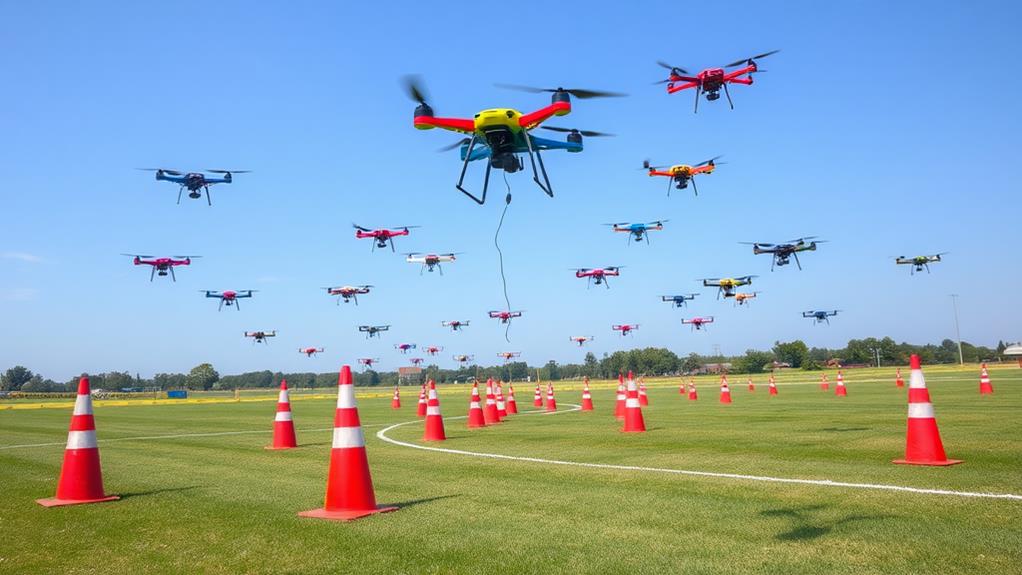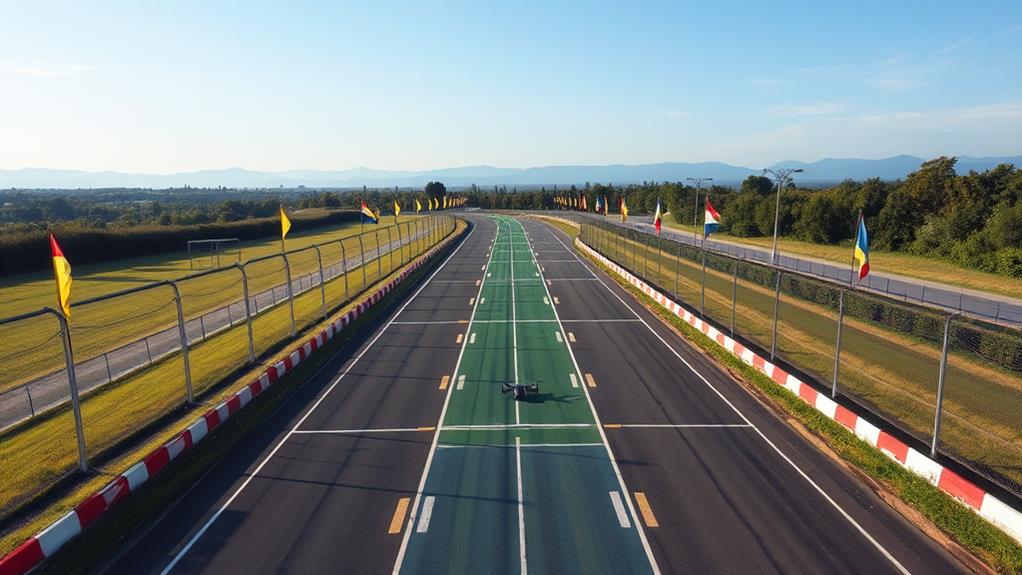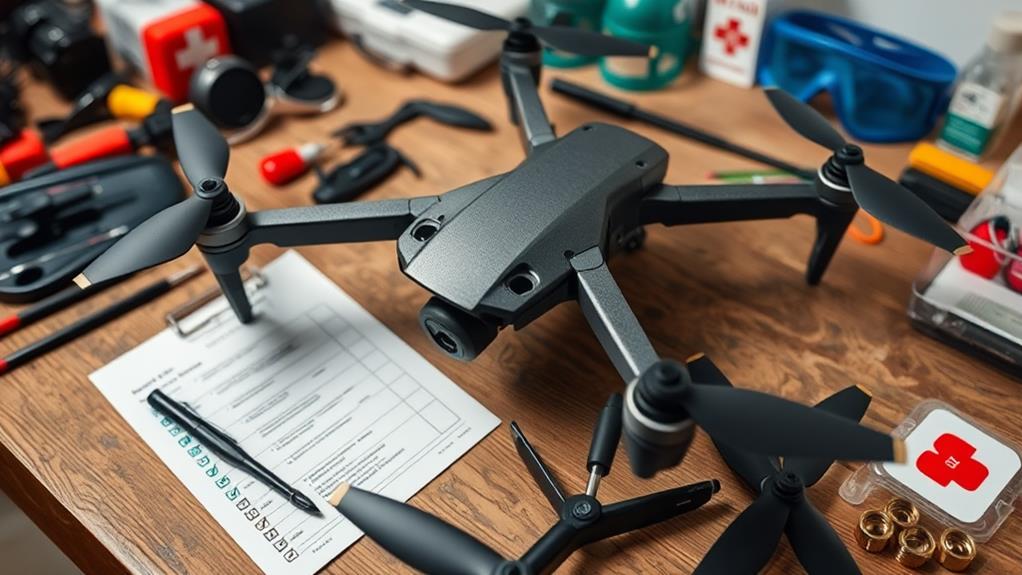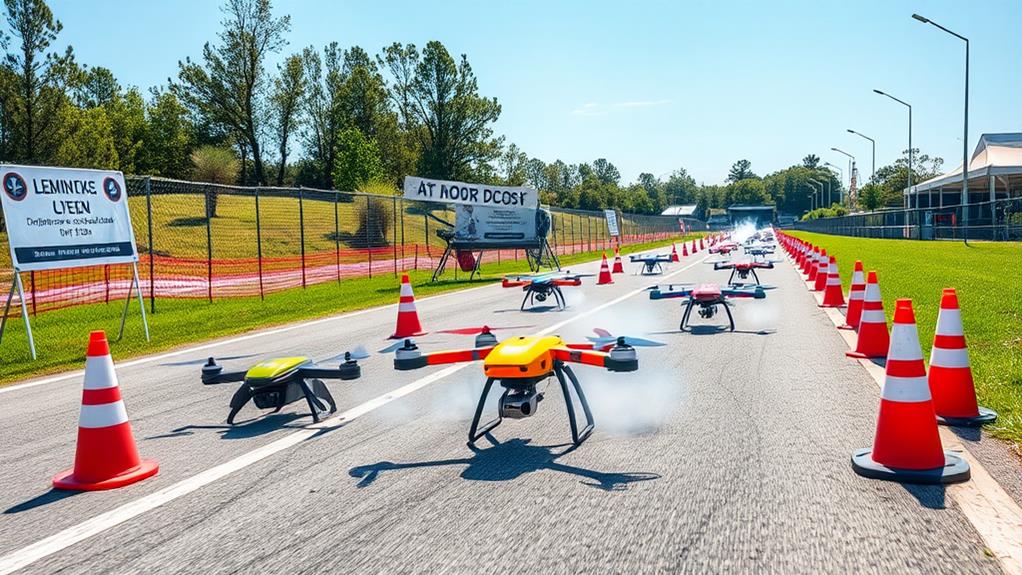To guarantee a safe and enjoyable drone racing experience, adhere to essential safety guidelines. Always maintain visual line of sight (VLOS) to minimize collision risks and fly in open spaces. Familiarize yourself with local drone laws and guarantee compliance with FAA regulations, including registration and airspace authorizations. Before racing, conduct thorough pre-flight inspections for equipment integrity. Create a safety plan for emergencies, like signal loss, and have a fire extinguisher ready for LiPo battery issues. Engage with your community for shared insights, as this enhances safety and skill development, paving the way for further exploration of best practices in drone racing.
Overview of Safety Guidelines

When it comes to drone racing, understanding safety guidelines is important for every pilot's peace of mind. These guidelines help guarantee that you not only enjoy the thrill of high speeds but also prioritize safety for yourself and others.
First, you must maintain a visual line of sight (VLOS) during your flights. This means you should always be able to see your drone without any obstructions, which greatly reduces the risk of collisions. Additionally, selecting safe flying locations is essential; choosing open spaces minimizes risks associated with crowded areas and potential collisions.
Additionally, familiarize yourself with local laws regarding drone use. This includes yielding the right of way to manned aircraft and avoiding restricted flight areas. You'll also need to pass The Recreational UAS Safety Test (TRUST) and keep proof of passage handy, as this illustrates your understanding of important safety protocols.
Pre-flight inspections are important too; check your propellers, battery condition, and wiring to catch any hazards before takeoff.
Pre-Race Preparations
How can you guarantee a smooth and safe racing experience? First, start with thorough pre-flight inspections of your racing drone.
Check for loose parts, battery condition, and propeller integrity to verify safe operation during the race. A well-maintained drone is essential for peak performance.
Next, familiarize yourself with the course layout and any potential obstacles. This enhances your situational awareness and helps you plan your racing strategy effectively.
Additionally, review the weather conditions before the race. Wind and visibility can greatly impact your drone's performance and safety.
Don't forget to check your equipment. Confirm that all necessary tools, including FPV goggles and remote controllers, function properly and have been tested before the race begins.
A malfunction at the wrong moment can lead to disastrous results.
Safe Operating Practices

Consistently following safe operating practices is critical for a successful drone racing experience. Prioritizing safety not only protects you and your drone but also guarantees a smoother, more enjoyable race. Here are some key practices to adopt:
- Conduct thorough pre-flight inspections, checking for loose parts, battery condition, and motor function. Regular maintenance and pre-flight checks guarantee airworthiness.
- Maintain visual line of sight (VLOS) during flight to avoid collisions and comply with legal requirements.
- Keep your drone away from crowds and restricted areas to minimize accident risks and legal issues.
- Utilize a failsafe system that automatically returns your drone to a designated location if you lose signal.
Additionally, it's crucial to familiarize yourself with local regulations before racing. This knowledge helps you guarantee safety and compliance with flying in controlled airspace.
By adhering to these safe operating practices, you'll boost your confidence and performance in FPV racing. Remember, a well-prepared pilot is a successful pilot.
Emergency Response Strategies
In the fast-paced world of drone racing, having a solid emergency response strategy is fundamental. Operators should develop a thorough safety plan for in-flight emergencies, including protocols for handling loss of control or equipment malfunctions.
If you experience signal loss, unexpected obstacles, or any sign of equipment failure, it's essential to execute an immediate landing to guarantee the safety of everyone involved. Additionally, verifying that your drone is properly registered with the FAA DroneZone can promote accountability and help in managing any safety incidents effectively.
Visual observers play an important role in monitoring the flying environment, providing necessary assistance during emergencies. They can help identify potential hazards and guide you to safe landing spots, especially when visibility is low.
When racing with lithium polymer (LiPo) batteries, remember to keep a fire extinguisher on hand for emergencies related to equipment malfunctions. This simple precaution can prevent a minor issue from escalating into a serious threat.
Familiarizing yourself with the flying area during daylight hours is another significant step. By identifying potential hazards and safe landing spots before night flights, you're following safety guidelines that will benefit both you and your fellow racers.
Equipment Maintenance and Checks

Your drone's performance hinges on regular equipment maintenance and checks, which are essential for safe racing. Neglecting these checks can lead to accidents and jeopardize safety in FPV. To guarantee your drone is always race-ready, follow these key practices:
- Conduct thorough pre-flight inspections, checking for loose wires, damaged props, and battery condition.
- Remove propellers during any power-on debugging or maintenance to prevent accidental injuries.
- Regularly monitor and maintain battery health, charging lithium polymer (LiPo) batteries at a safe rate (1C recommended) and never leaving them unattended.
- Perform test hovers after repairs or prop changes, keeping a safe distance from people to minimize risk.
Additionally, keep a log of your maintenance activities and inspections. This practice helps track your drone's performance and condition, facilitating timely repairs and replacements.
Always be aware of the regulations regarding flying locations and any specific requirements that apply to your racing events.
Community Safety Engagement
Maintaining a well-functioning drone is just one aspect of ensuring safety in the racing community. Engaging in community discussions allows you to share essential experiences and safety tips with fellow pilots. This exchange fosters a culture of collective responsibility, which is important as racing continues to grow.
Consider conducting polls within your community to gather valuable safety suggestions and practices. This can enhance overall safety awareness among enthusiasts.
Establishing mentorship programs can also connect novice pilots with experienced ones, providing guidance on safe flying practices and effective risk management strategies. Regular community meetings and events should be held to facilitate the exchange of knowledge about recent safety regulations and technological advancements in drone racing.
Encouraging pilots to document and share their safety experiences creates a repository of best practices that benefits everyone involved. By actively participating in these initiatives, you contribute to a safer environment for yourself and your peers.
Legal Compliance and Regulations

When it comes to drone racing, understanding legal compliance is vital for safe operations.
You need to be aware of the Recreational Flight Exception, which prohibits flights for compensation, and guarantee your drone is registered if it falls within the specified weight range.
Additionally, always check airspace authorization requirements, as flying in controlled areas requires prior approval, but you can streamline this process with the FAA's LAANC system.
Recreational Flight Exception
Understanding the Recreational Flight Exception is vital for any drone enthusiast looking to fly legally and safely. This regulation, outlined in 49 U.S.C. § 44809, allows hobbyists to operate FPV drones for recreational purposes without needing a commercial pilot certificate.
However, it's important to comply with specific guidelines to avoid legal trouble.
Here are some key points to keep in mind:
- You must fly strictly for recreation—no business-related activities allowed.
- Register your drone if it weighs between 0.55 pounds and 55 pounds, making sure the registration number is visible on the aircraft.
- You can operate in Class G airspace without prior authorization but must maintain a Safe Distance from people and structures.
- Stay below 400 feet AGL, especially in high winds, to guarantee safety.
Non-compliance can lead to FAA enforcement actions, including fines.
Airspace Authorization Requirements
Maneuvering airspace authorization requirements is essential for any drone pilot aiming to comply with legal regulations.
If you're flying racing drones, it's important to understand the airspace around you. While you don't need authorization to operate in Class G airspace below 400 feet, you must get prior approval for Class B, C, or D airspace. This is where the FAA's Low Altitude Authorization and Notification Capability (LAANC) system comes in handy, allowing you to request near real-time authorization for flying in controlled airspace.
You must adhere to 49 U.S.C. § 44809, which includes following airspace regulations and operational limits. Ignoring these rules can lead to unauthorized flights, resulting in fines or other enforcement actions from the FAA.
To guarantee compliance, always check for Temporary Flight Restrictions (TFRs) and Notices to Airmen (NOTAMs) before planning your local FPV sessions. Staying informed helps you avoid potential legal issues and keeps the skies safe for everyone.
Mental Preparedness for Pilots
Mental preparedness is key for pilots, as managing stress and maintaining focus can greatly impact your racing performance.
You'll want to explore techniques that enhance concentration, like mindfulness practices, which can help you stay calm under pressure.
Additionally, using simulations and setting achievable goals during practice can build your confidence and prepare you for the challenges ahead.
Stress Management Techniques
Drone racing can be exhilarating, but it often comes with a wave of pre-race anxiety that can hinder your performance. Managing this stress is vital for achieving mental clarity and maintaining your focus. Here are some effective stress management techniques you can implement before your race:
- Practice Mindfulness: Incorporate deep breathing exercises to calm your nerves and stay centered.
- Engage in Physical Activity: Stretching or light exercise can notably reduce stress and enhance your overall mental clarity.
- Set Realistic Goals: Establish achievable objectives for each race, preventing feelings of overwhelm and allowing you to celebrate incremental progress.
- Utilize Visualization: Imagine successful race scenarios to boost your confidence and prepare your mind for high-pressure situations.
Additionally, adhering to the IMSAFE checklist (Illness, Medication, Stress, Alcohol, Fatigue, Emotion) is essential. This guarantees you're in ideal mental and physical condition before flying, considerably lowering the chances of stress-related performance issues.
Focus and Concentration
Clarity of thought is essential for any pilot aiming to excel in drone racing. Maintaining focus and concentration is vital, as distractions can lead to loss of control and potential accidents during high-speed maneuvers.
To guarantee you're mentally prepared, use the IMSAFE acronym—Illness, Medication, Stress, Alcohol, Fatigue, and Emotion—to assess your readiness. Remember, even mild fatigue can impair your cognitive functions, reducing reaction times by up to 50%, which can dramatically impact your performance.
Engaging in pre-flight mental exercises, like visualization techniques, can greatly enhance your focus. Picture yourself steering through the course, anticipating turns and obstacles; this immersive experience primes your mind for actual racing.
In addition, regularly participating in community racing events not only hones your skills but also fosters a supportive environment that enhances mental preparedness. Sharing experiences and tips with fellow pilots can bolster your concentration and help you learn effective strategies for tackling challenging racing conditions.
Conclusion
In the world of drone racing, safety isn't just an option; it's your flight path to success. By following these essential guidelines, you're not only protecting yourself but also ensuring a thrilling and responsible experience for everyone involved. Think of safety as your drone's GPS, guiding you through the twists and turns of competition. So, gear up, stay informed, and fly smart—because when you prioritize safety, you're setting the stage for unforgettable races ahead.

Leave a Reply